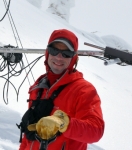The first turns of the ski season can be dicey: the snowpack is thin, avalanche skills are rusty and we are itching to get out and play. This is a recipe for avalanches and injury, not success. Fortunately, our stoke and motivation can make us ready for better, deeper times. We wax skis, tune sleds and rip tags off new gear to get ready, but we are not done. What causes avalanches? You! More than 90 percent of fatal recreational avalanche are triggered by the people involved.
Blog List

Digging a Snowpit Matters
An online article posted October 29, 2015 for BackcountryMagazine.com on snowpits, avalanche character, and the difficulties and risks of traveling in various types of snow, is a welcome early season jump-start to get us thinking about snow and avalanches. Every snow climate is different and every professional forecaster looks at the snowpack through his and her own forecasting lens, but we are all trying to increase the understanding of avalanches in order have fun and stay alive.

Chris Lundy, owner of Sawtooth Mountain Guides, wrote a great article in Backcountry Magazine about digging pits. He opens the story with a personal account of triggering an avalanche. I was with him that day. We triggered the slide up Fisher Creek outside Cooke City on March 10, 2002.

On February 25, 2015 the Panjshir Valley in Afghanistan had an avalanche cycle that killed at least 168 people. The reports at the time claimed over 200 dead making international headlines. A few weeks ago I visited the valley and wrote this "Official" report. I wrote it for Hameed Habibi who runs the Afghanistan Avalanche Control Team at the Salang Tunnel.
The fatality numbers (168) are the best we could gather based on interviews. If anything, they might be slightly understated.

April 16, 2015
Greetings:
What a strange year it has been. We started strong with many storms and early season snow, followed by spring weather in February and March and then one of the biggest snowfalls of the season yesterday. Go figure. Although skiing and snowmobiling conditions were bipolar, the snowpack was generally stable with more days of “Low” avalanche danger than any of us can remember.

Spring skiing can be some of the best of the season. Good snow coverage, warmer weather and more predictable snow stability (at times) can lead to unmatched conditions. While spring skiing can be the best, it can also hold avalanche hazards not encountered during the colder parts of winter.
As snowpack and weather transition into a warmer and wetter spring pattern, there are a number of avalanche variables to pay attention to.

Spring skiing can be some of the best of the season. Good snow coverage, warmer weather and more predictable snow stability (at times) can lead to unmatched conditions. While spring skiing can be the best, it can also hold avalanche hazards not encountered during the colder parts of winter.
As snowpack and weather transition into a warmer and wetter spring pattern, there are a number of avalanche variables to pay attention to.

Five Easy Steps to Safe Backcountry Riding
By: Eric Knoff
Gallatin National Forest Avalanche Center

Avalanche information can sometimes be overwhelming. Without becoming a snow scientist, recreational riders can take a few simple steps to become better educated in avalanche awareness. During the summer of 2013, the International Snowmobile Manufactures Association, Canadian Avalanche Center and USDA Forest Service National Avalanche Center collaborated to produce a simple yet effective avalanche safety messaging system for snowmobilers. The messaging system consists of five bullet points.

The snowpack changes from year to year, even day to day but, the terrain on which snow falls remains constant. Understanding and recognizing avalanche terrain are critical tools for safe decision making in the backcountry.
During stable snow conditions, riding in avalanche terrain is safe and acceptable. When snow conditions are unstable, avoiding steep slopes and avalanche run out zones is key to avoiding avalanches.

The snowpack changes from year to year, even day to day but, the terrain on which snow falls remains constant. Understanding and recognizing avalanche terrain are critical tools for safe decision making in the backcountry.
During stable snow conditions, riding in avalanche terrain is safe and acceptable. When snow conditions are unstable, avoiding steep slopes and avalanche run out zones is key to avoiding avalanches.

Lynne Wolfe, editor of TAR, asked me to jot a few thoughts down on how we manage surface hoar once it is buried. This is the email I sent back to her.

Published in the April 2015 issue of The Avalanche Review.
Lynne Wolfe, editor of TAR, asked me to jot a few thoughts down on how we manage surface hoar once it is buried. This is the email I sent back to her.

R: RESTRICTED. Under 17 requires accompanying parent or adult guardian.

Published in the January 2015 issue of Carve.
R: RESTRICTED. Under 17 requires accompanying parent or adult guardian.
An R-rated film includes “…adult themes, adult activity, hard language, intense or persistent violence or other elements, so that parents are counseled to take this rating very seriously.” Sidecountry is more serious than the most serious film because people of all ages can die in the sidecountry, especially youth that lack adult supervision or perspective. A young adult sneaking into a theater might face consequences if caught, but heading out-of-bounds of a ski area into the sidecountry is an entirely different level of risk.

The winter of 2013/14 was a busy one for the Gallatin National Forest Avalanche Center. Over the course of the winter, 80 avalanche incidents were reported in southwest Montana. The incidents reported included 33 people caught, 5 partial burials, 5 full burials and 2 fatalities, but this is, unfortunately, not the full picture. Inherently, many avalanche events were never reported to the forecast center.

Published in the February 2015 issue of The Avalanche Review.
The Class

By Doug Chabot
Published in the February 2015 issue of The Avalanche Review.
As an avalanche forecaster and educator I pay close attention to teaching the recreating public about heuristic traps, aka human-factors, and their role in avalanche accidents. A powerful voice is Powder Magazine’s riveting five-part Human-Factors series which did a great job of pointing out those traps.

As an avalanche forecaster and educator I pay close attention to teaching the recreating public about heuristic traps, aka human-factors, and their role in avalanche accidents. A powerful voice is Powder Magazine’s riveting five-part Human-Factors series which did a great job of pointing out those traps.

The Class
One night in 1981 Doug Richmond and Tom Pratt decided to offer an avalanche class at Montana State University for both students and people living in the community. Seven nights of lectures for $7. At the time a beer was a dollar, and they figured each lecture was worth a beer. Now, 33 years later, we only charge $30. The class has four lectures over two nights followed by a field day just out of bounds at Bridger Bowl which has been a supporter of the class from the beginning. In the last ten years, we have taught this class to more than 3,000 people. It is called Introduction to Avalanches with a Field Session.
